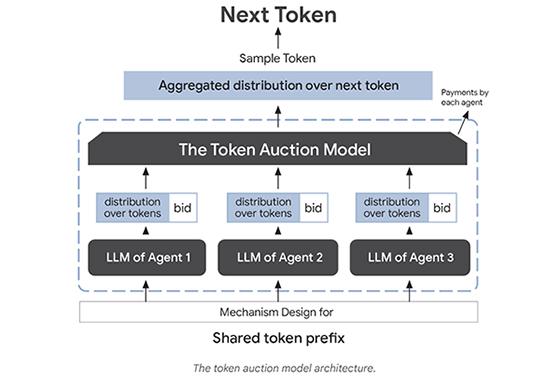Commentary
Google's New Type Of Ad Auction, Reason Clean Fusion Power Is Needed
- by Laurie Sullivan , Staff Writer @lauriesullivan, June 30, 2025
Google Research and the University of Chicago earlier this year published a paper outlining a theoretical and practical framework for how ad auctions could work in the age of generative AI.
The framework advances things like real-time ad serving and bidding introduced as a part of programmatic advertising to allow advertisers to buy individual impressions on websites in a real-time auction. Or, Responsive Search Ads (RSAs) in July 2018.
This model advances with AI, with a new generation of large language models (LLMs) that introduces ads written in real-time based on an auction for words being generated.
Researchers of the paper “Mechanism Design for Large Language Models” argue that the problem of joint output generation through multiple LLM agents comes with several unique challenges, but the researchers present a new type of ad auction to address them.
advertisement
advertisement
The paper shows how the insights lead to practical auction designs that yield promising outcomes when deployed with real-world LLMs.
The approach, which researchers named the “token auction model,” mimics the mechanics of LLMs.
“The token auction operates on a token-by-token basis and functions like one giant LLM, while also defining some payment function, monetary or otherwise,” the research paper explains the process.
“We illustrate the key ideas and concepts in the context of text creation, but the same ideas apply to the creation of other media types (such as images or videos). In this context, a token is simply an individual word, a sequence of words, punctuation mark, etc. There is also a special 'end' token signifying the end of the creation process.”
Researchers describe the function as an auto-regressive text generation. The process begin with an initial prompt, which is just a sequence of tokens.
A token is sampled from the distribution over tokens defined by the LLM. This token is appended to the sequence being generated, and the process is repeated.
The token auction performs two key tasks: expanding the shared token sequence and determining agent payments.
Both tasks are achieved through functions, which researchers refer to as the distribution aggregation function and the payment function.
Advertisers in this framework no longer submit static ad copy or landing pages. They will teach LLMs how to speak in their brand’s voice, because the model will act as an extension of the brand.
While companies like Cisco Systems will become the lifeline, server-based companies and energy will become the fuel to power AI-generated ads in real-time based on historical data, sentiment and consumer actions.
That AI-based advertising will require processing power and energy -- a lot of it.
Google on Monday announced the first purchase of fusion energy from Commonwealth Fusion Systems (CFS). The company plans to purchase 200 megawatts (MW) of carbon free energy from CFS’s first commercial plant, to be developed in Chesterfield, Virginia. it's the company's second investment in CFS.
Michael Terrell, head of advanced energy at Google, believes by making this investment, the company hopes to accelerate one of the most promising pathways to commercial fusion.
“Achieving this potential will be immensely challenging, and success is not guaranteed," Terrell wrote. “But if it works fusion could help meet the world’s energy needs for generations to come.
Fusion is clean, abundant and inherently safe, and facilities that generate it can be built just about anywhere.
While
companies like Cisco Systems will become the lifeline, server-based companies and energy like the fuel Google wants to nurture will become the fuel to power AI-generated ads in real-time based on
historical data, sentiment and consumer actions.





Please have a look at two paragraphs in this article:
and...
It looks like a small glitch slipped in :)
Besides that, great article. I'm looking forward to 2027, although I haven't quite understood why CFS believes they can beat all the others (not only in the US, of course; I'm thinking France and the UK, for example, among others) and get Q>1 measured within statistical significance on a lab prototype so soon.
I'm all for fusion energy, of course, and believe it to be the only viable future form of energy — the problem is only that it's always coming 30–50 years in the future. :)
It may be true that a fusion power plant can run on a truckload of seawater for 30 years, but, right now, all that drives fusion power is... billions of dollars!